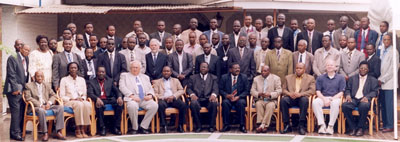Chris Funk is an associate researcher with the Geography Department’s Climate Hazard Group (CHG). The CHG’s eight scientists and four graduates focus on the remote sensing and prediction of hydrologic extremes that impact poor people in Africa, Asia, and Central America . The CHG has field scientists stationed in Botswana, Kenya, Niger, Guatemala, and Afghanistan. These scientists work in their regions to identify and help prevent encroaching famine conditions. New work by Prof. Michaelsen and Dr. Greg Husak uses high resolution satellite imagery to map cultivated area from space. Dr. Funk’s work specializes in developing geospatial models of environmental variables, climate modeling and forecasts, and climate change analysis of tropical moisture transports and precipitation. The CHG’s combination of climate research and application can sometimes quickly transition new science into better decisions, helping to save lives in the process.
What do twenty square miles of snow and ice, India Pale Ale, and Sir Gilbert Walker have in common?
Despite the fact that some 100 billion people have lived and died on planet earth, not many people have asked this question. Sir Gilbert Walker was the Royal Meteorologist in India from 1904 to 1934. He first identified the important climate pattern known as the ‘Southern Oscillation.’ This large scale pressure difference between Darwin and Tahiti is now known to be tightly coupled with changes in the Pacific Ocean circulation associated with El Niño and La Niña. Old Sir Gil dreamed of being able to use these climate variations to predict drought in India, thus saving lives. This has largely remained an unrealized dream. Over the past 30 years though, satellites, models, and improved ocean monitoring have dramatically expanded our ability to monitor and predict the large scale climate.
Geography and remote sensing has a great deal to offer Sir Gil, as a recent EOS article summarizing some of our work details. For example, it is possible to build large numbers of spatially-varying statistical models that relate observed sea surface temperatures (SSTs), winds, and precipitation to future rainfall. For eastern and southern Africa, these models link seasonal rainfall variations to changes in the tropical oceans, synoptic circulation patterns, and patterns of diabatic forcing. We used this approach in the fall of 2006 to forecast November-to-March standardized precipitation across eastern and southern Africa. The regional climate was pretty exciting, in a Kosovo sort of way, with positive Indian Ocean dipole conditions coinciding with a modest El Niño and warmer than normal Indian Ocean SSTs . Our modeling suggested that drought across southern Africa and flooding across eastern Africa were likely, and that these hydrologic anomalies could, respectively, be associated with failed crops and outbreaks of mosquito-borne diseases like malaria and Rift Valley Fever. Unfortunately, this came to pass.
Geography can also assist in climate forecasting by adding additional spatial information to coarse probabilistic estimates. For example, climate specialists in Africa routinely assemble at Climate Outlook Fora (COFs) to discuss, you guessed it, the climate. These scientists combine models and expertise, deriving polygons associated with the probabilities of rainfall being above or below normal. By associating these probabilities with maps of gamma distribution parameters, maps of precise rainfall anomalies may be generated and linked to likely food security outcomes.
Recently, scientists gathered in Nairobi this August and prepared a forecast for the September-December ‘short’ rainy season. Climate Hazard Group scientist Gideon Galu, stationed in Nairobi, translated this forecast into rainfall anomalies and worked with food security experts to prepare high level overviews summarizing likely outcomes. In this way, information travels from climate experts in Africa to decision makers in D.C. Dr. Galu also works to send the information, via radio, to farmers and pastoralists in remote, drought-prone regions of Kenya
Careful readers are probably wondering where the beer went. And what that has to do with twenty square kilometers of snow and ice. Well, as you probably know, India Pale Ale was invented in the 18th century by industrious Englishmen (bless them) as a hoppier, more alcoholic brew that could withstand the long hot voyage around the Cape of Good Hope to India. These early voyages would need to be carried by the seasonal monsoon winds that sweep from the southeast to northwest during the summer. These winds also carry moisture to eastern and southern Africa, helping to sustain rainfall and agriculture. As the Indian Ocean warms, however, tropical oceanic convection disrupts these transports, and this increases the frequency of drought. We’ll be presenting this material at the AGU in January and at the American Academy of Sciences in February.
Oh – the ice. Well, as you may know, Kilimanjaro’s glaciers have decreased dramatically since the 1880s (from about 20 square km to about 2.5 square km). One very plausible explanation for this is a decrease in atmospheric moisture, which could be related to decreasing onshore moisture transports from the Indian Ocean – and more frequent drought in eastern and southern Africa (Mote, P. and G. Kaser. 2007. The Shrinking Glaciers of Kilimanjaro: Can Global Warming Be Blamed, American Scientist, 95(4), 318-325). This means that our friends in eastern and southern Africa may be getting the short end of the climate change hockey stick.






